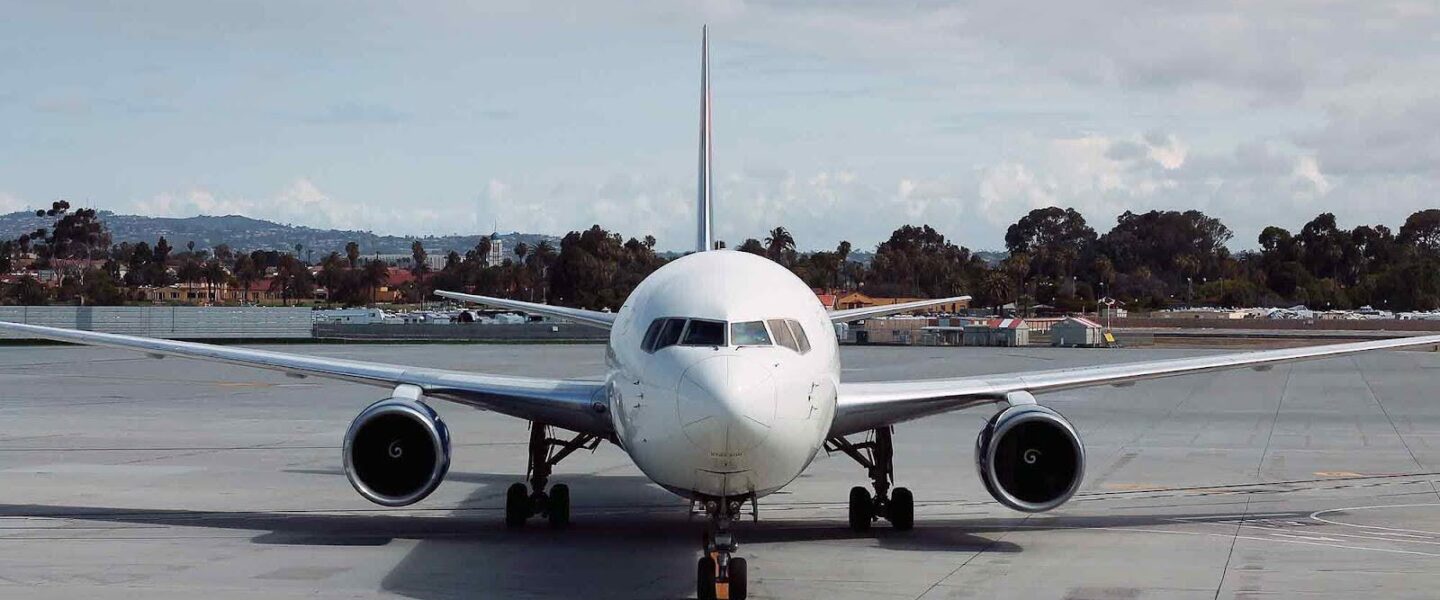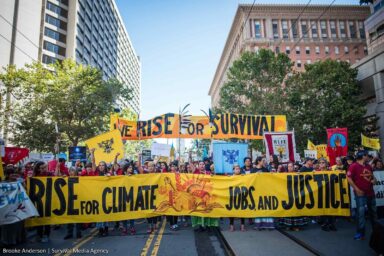Increasing air travel is erasing the industry’s efforts to reduce its climate impact. Here’s how the sector is adapting.
|
Listen To This Story
|
Buoyed by a revival in global demand for international travel, growth in air traffic has surged post-pandemic. But it’s not just carriers crowding the skies. The spike in air travel directly contributes to worrisome increases in greenhouse gas emissions, generated by an industry that already delivers an outsized share of climate-warming pollutants.
Aviation is responsible for 13.9 percent of the world’s carbon dioxide emissions from transport and 2.5 percent of emissions from all human activity. Between 2000 and 2019, emissions from the aviation sector have risen faster than those from rail, road or shipping — in 2024 alone, GHGs jumped by 5 percent — while efforts to decarbonize the aviation industry have made little progress.
Recently, however, there have been indications that this may change. The International Air Transport Association (IATA) set a target for international aviation to be 5 percent less carbon-intensive by 2030 and achieve carbon neutrality by 2050. This will primarily be through the use of sustainable aviation fuels (SAFs), which are typically made from used cooking oil and agricultural waste and mitigate the lion’s share of emissions produced by conventional jet fuel. Canada’s Aviation Climate Action Plan targets net-zero emissions for the aviation industry by 2050 and a goal of 10 percent use of low-emission aviation fuel by 2030.
Given the sluggish pace at which airlines are replacing jet fuel with SAFs, not to mention the projected growth of air travel, reaching these milestones appears unlikely. Passenger air travel is expected to double by 2050. “Even the most ambitious jurisdictions are falling short of tracking to net-zero,” says Nikita Pavlenko, director of aviation and fuels at the International Council on Clean Transportation’s Washington, DC, office. “In aviation, there are no silver bullets to decarbonization. In the auto sector, there’s electrification. In the power sector, there’s renewables. In the aviation sector, there are not the same kind of easy answers.”
Others have struck a more hopeful note. Geoff Tauvette, executive director of the Canadian Council for Sustainable Aviation Fuels (C-SAF), a nonprofit representing more than 100 industry members, writes in an email that “Canada has all the right ingredients from start to finish to build a leading and made-in-Canada SAF production market.”
While developing a healthy market for SAFs will require a long-term regulatory framework and investment strategy, the smart money is on cleaner fuels, more than initiatives to increase efficiencies, to drive aviation decarbonization in the decades ahead.
Air Travel Takes Off
Between 2013 and 2019, global demand for air travel increased by 50 percent, jumping another 10 percent in 2024 — 4 percent above pre-pandemic levels, an all-time high, according to figures released by IATA in January. IATA expects air travel to climb 6 percent this year, causing another surge in emissions.
In addition to carbon dioxide, airplanes emit pollutants such as nitrogen oxide and soot and form heat-trapping contrails. Scientists estimate that the net warming effect of these may be up to three times as great as the warming caused by the carbon dioxide emitted.
To realize the 2030 target, airlines would need to boost consumption of SAFs more than 30-fold. Some fear, however, that even if airlines replace 10 percent of their fuel with low-carbon alternatives by the end of the decade, the climate benefits would be erased by the anticipated growth in the aviation business.
Bending the Curve
Reducing the carbon footprint of the aviation sector is one of the most difficult pieces of the energy transition, largely because it requires multiple solutions and the technology required is not yet available at scale. Writing in Nature, a science publication, researchers point out that zero-emission aviation demands a holistic approach, which includes increasing efficiencies in propulsion systems, making improvements to aircraft design and using low-carbon materials.
Carbon reductions in the production of conventional fuel, electrifying ground operations and route planning designed to minimize stopovers all represent additional levers to lighten aviation’s climate impact.
While such efforts are worthwhile, the resulting emission reductions are marginal. Numerous experts have concluded that replacing diesel with SAFs is the most viable near-term pathway for meaningful decarbonization. SAFs are liquid fuels derived from sustainable sources, versus conventional jet fuel that comes from crude oil. The cleaner fuels can mitigate as much as 80 percent of carbon dioxide in life-cycle emissions compared to conventional fuel. Moreover, “SAF is appealing because you can use it in existing aircraft,” Pavlenko says, noting that the European Union is leading the pack in the deployment of sustainable fuels.
Says Tauvette in an email, “It is critical that government and industry work together to properly assess the impacts and develop an SAF policy that helps reduce actual aviation emissions, supports creating value from Canadian feedstocks by producing SAF in Canada and enhances the competitiveness of the sector.”
A Flight Path to Net-Zero
The European Union aims for a 55 percent reduction in aviation emissions by 2030 and net-zero by 2050, leveraging SAFs and emission trading systems. China plans to achieve carbon neutrality by 2060, focusing on green airports and SAFs. Japan and the United Kingdom also target net-zero by 2050 and have drafted strategies that emphasize sustainable fuel, hydrogen-powered aircraft, and optimized air traffic management.
In Canada, British Columbia became the first jurisdiction in North America to require the use of SAFs in 2023, when the province released its revised low-carbon-fuels program.
The regulations now require renewable fuel to comprise at least 1 percent of jet fuel starting in 2028, increasing to 2 percent in 2029 and 3 percent in 2030 and subsequent compliance periods. The regulations also require a carbon-intensity reduction for conventional jet fuel. (The federal Clean Fuel Regulations set life-cycle carbon-intensity-reduction requirements for gasoline and diesel but does not have a reduction requirement for jet fuel.)
Currently, the high cost of low-emission aviation fuels — often far exceeding that of conventional jet fuels — has prevented widespread adoption. “The reality is that there is going to be a significant cost premium for SAF in the foreseeable future. It’s just going to be more expensive than fossil fuel,” Pavlenko says.
In its 2023 road map, C-SAF put forward an optimistic target of one billion litres of SAF production by 2030. Uptake would result in a 50 percent reduction, or more, in life-cycle greenhouse gas emissions relative to fossil fuel, which translates into the elimination of approximately 1.6 million tonnes of GHG emissions.
Earlier this year, Boeing announced that it will invest $17.48 million to promote the production of SAF in Canada, an encouraging signal that some investors see a long-term future for decarbonization. “Just getting a handful of commercial scale projects built to produce those second-generation technologies comprises a significant step forward for the industry and would help achieve some of those longer-term targets,” Pavelenko says. Anything less, and “we’re going to fail to achieve our 2050 goals.”
This story by Victoria Foote was originally published by Corporate Knights and is part of Covering Climate Now, a global journalism collaboration strengthening coverage of the climate story. WhoWhatWhy has been a partner in Covering Climate Now since its inception in 2019.





